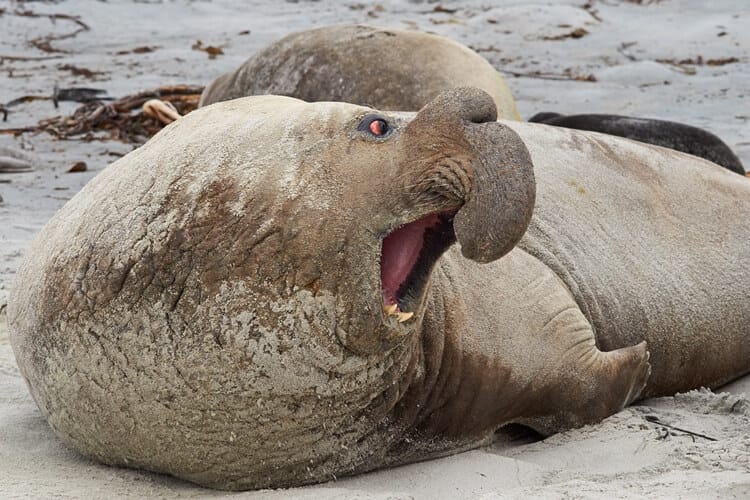What Elephant Seals Can Tell Us About Using Carbon Monoxide to Heal

Adapted for an APS news release
New study looks to marine mammals as a model for understanding and improving carbon monoxide-based therapies in humans
In a new study, most marine mammals were found to exhale carbon monoxide at levels equivalent to or greater than the amount exhaled by a several-packs-a-day smoker. The research led by researchers at Scripps Institution of Oceanography at UC San Diego is part of a broader investigation into how marine mammals’ naturally high levels of circulating carbon monoxide might protect tissues in low- or no-oxygen environments, such as during extended dives. The findings could help researchers refine approaches for carbon monoxide-based therapies in humans, which are currently being tested in clinical trials.
While it is deadly to humans at high levels, carbon monoxide in moderate doses has been found to help reduce inflammation and tissue damage from being exposed to conditions such as low oxygen or reduced blood flow. Ongoing clinical trials are testing its therapeutic potential for patients with lung injuries, the infection complication known as sepsis, and other conditions.
“We’re excited about this research because marine mammals, and elephant seals in particular, are one of the only models where we see carbon monoxide at the elevated levels which are considered therapeutic,” said Michael Tift, a doctoral candidate at Scripps Oceanography, who conducted the research. “We think the elephant seal has, over millions of years of evolution, potentially figured out how to manage this carbon monoxide system in a way that’s beneficial for the animal.”
“If we can understand what levels of carbon monoxide offer the most benefit to the animal, and how the animals maintain these therapeutic levels, there is hope that we can use this information to assist in treating certain injuries and pathologies,” said Tift.
Tift presented the research findings at the American Physiological Society Annual Meeting during Experimental Biology 2016.
The researchers tested carbon monoxide levels in the blood and exhaled breath of nine killer whales, eight northern elephant seals, seven bottlenose dolphins, five beluga whales, three short finned pilot whales, and one Hawaiian monk seal. They found that most marine mammals exhale carbon monoxide at around 6 parts per million—comparable to the elevated carbon monoxide level exhaled by a person who smokes several packs of cigarettes per day—or higher, and that the elephant seal exhales carbon monoxide at 40 parts per million. The researchers also found that these levels can be equally as high in the blood of the animals.
Marine mammals are a good experimental model because of their relatively abundant red blood cells and high levels of a blood protein known as hemoglobin. In people as well as marine mammals, carbon monoxide is produced as a byproduct of the red blood cell life cycle. When these cells break down after a typical lifespan of less than four months, hemoglobin is released into circulation. A component of hemoglobin known as heme is then further broken down by enzymes to create carbon monoxide, which makes its way to the lungs and is ultimately exhaled.
The researchers hypothesized that marine mammals with higher levels of hemoglobin and red blood cells would have higher levels of carbon monoxide, and that marine mammals could therefore offer useful insights for improving carbon monoxide-based therapies. The study findings confirm that carbon monoxide levels are indeed linked to hemoglobin levels and suggest the elephant seal, which has the highest levels, can provide a useful model organism for future studies on the potential protective effects of carbon monoxide.
In addition to having one of the highest concentrations of red blood cells and hemoglobin of any mammal ever tested, elephant seals are known to regularly experience a phenomenon known as ischemia-reperfusion during long dives and while sleeping on land. Ischemia is when blood flow to tissues is reduced and reperfusion is when blood flow returns to those tissues. Diving animals regularly reduce blood flow to specific tissues while holding their breath in order to preserve oxygenated blood for the brain and heart. In people, making tissues ischemic can be highly damaging—it is what causes permanent damage to the heart after a heart attack, for example—but elephant seals appear to resist this damage, and the researcher thinks carbon monoxide could help explain why.
As a next step, the researchers plan to investigate how carbon monoxide in the blood might help to protect elephant seals against ischemia-reperfusion injuries. They also plan to study carbon monoxide production in penguins and high-altitude species, such as llamas.
As a caveat, Tift said that although the study focuses on potential benefits of moderate levels of carbon monoxide, it does not suggest that smoking or exposure to other sources of combustion, which elevates carbon monoxide exposure, is in any way healthy. Cigarette smoke includes many extremely toxic chemical components and any benefit from moderate levels of carbon monoxide would not outweigh the harms from smoking.
The study was funded by grants from the Society for Integrative and Comparative Biology, the PADI Foundation, the National Institutes of Health and the U.S. Office of Naval Research. The animals used in the study are from Ano Nuevo State Park, and Long Marine Laboratory in Santa Cruz, and SeaWorld in San Diego and have been approved for use in research by the U.S. federal government.
Experimental Biology is an annual meeting comprised of more than 14,000 scientists and exhibitors from six sponsoring societies and multiple guest societies. With a mission to share the newest scientific concepts and research findings shaping clinical advances, the meeting offers an unparalleled opportunity for exchange among scientists from across the United States and the world who represent dozens of scientific areas, from laboratory to translational to clinical research. www.experimentalbiology.org
About the American Physiological Society (APS)
APS is a nonprofit organization devoted to fostering education, scientific research and dissemination of information in the physiological sciences. www.the-aps.org
Click HERE to Connect with your Daily Horoscope!
OMTimes Magazine is one of the leading on-line content providers of positivity, wellness and personal empowerment. OMTimes Magazine - Co-Creating a More Conscious Reality









